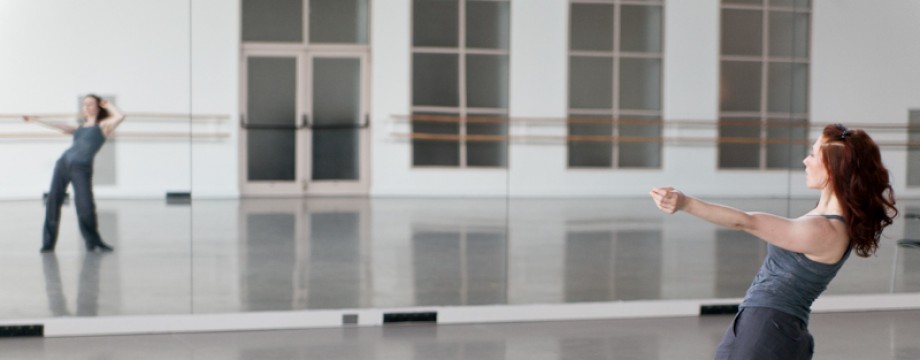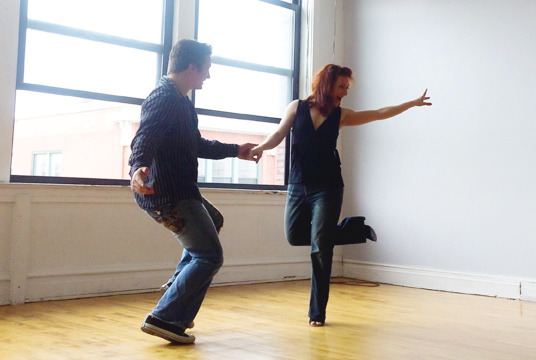Sara VanVreede asked Lucas Weismann and I this question after she watched us have a discussion about following during a practice session:
From Sara: I don’t know if it’s a class thought, a “help me sort this out for myself by talking about it” thought or something to look at in a lesson but…I’m hoping maybe you can at least help me stop making my brain spin every time I think about it.
So, when I was watching you and Ruby dance, the topic of matching your lead vs being given space to stylize came about, and Ruby commented that the less her lead gives, the more she matches/less flashy her movements are because she has little to respond to from her lead.
Is there ever a point in a class to address that sort of topic? Especially as follows are developing their own styles, we definitely get conflicting messages about styling vs matching. Plenty of times we hear “match your lead” and then in solo classes “move with the music” but at least with a number of MN leads, there’s an assumption that if they place a follow in open position, she is not supposed to match the lead except in pulse.
Personally I agree with Ruby that, sure I can make stuff up and solo, but I’d like to have something to react to from my lead. As dancers, I think we get a lot of “match your partner” and then also “leads, listen to your follow/let her do her own thing” (as far as I can figure out, those aren’t the same thing) and it gets super confusing and frustrating when you think one thing will happen when you place a follow in open and that thing you want, but didn’t explicitly lead, doesn’t happen.
I suppose the gist of this is: how does a lead successfully communicate that he wants a follow to do her own thing, and how does a follow explain, short of having a conversation prior to dancing, that maybe she wants or needs her lead to give her feedback?
Ruby’s Response:
First I want to summarize what I think this question is really asking and answer that, and then give some thoughts about my own personal order of operations when it comes to following, styling, giving input and affecting the dance.
How can you tell, short of having a verbal conversation about it, whether a lead wants you to be conversational? Or how you can encourage that?
Most importantly, I think the prima facie definition of partner dance is that it IS a movement conversation. There’s a flow of action/reaction that loops from the lead (who is simply the initiator of movement) and the follow (who is the responder). But the lead can’t not be impacted by how the follow responds to his/her action, so whatever happens next is going to be a response. To say that there is a form of partnered dance that does not involve this kind of feedback loop is simply to deny the existence of physics and human perception.
But, I know what Sara means. Do you just “walk down the line” or do you add extra rhythm, footwork and body shaping? These are choices we can make as follows that aren’t led, that are considered the “conversational” part of the dance. They can be inspired or suggested by the lead, or we can just “take the space” when it’s available.
This question allows me to address something that I feel is a common misconception about follows like myself— follows who have a demonstrated skill and preference for solo movement. The mistake leads often make with me is that they lighten up their lead, offering very little frame or support, or they lead lots of open moves that are supposed to “give me space” to express. The problem is when the leading is non-expressive or too vanilla. There’s nothing in the movement to give me ideas or something to respond to, so I follow quietly, just going with the direction and energy, and I don’t throw much back in terms of styling or footwork.
Leads who have something to say inspire me to respond. I’ve never had more fun bantering with Luke as when we went swing dancing. All his choreography was very firmly defined by the music, with a clear beginning and end from one swing-out to the next move. But within the confines of those eight counts, he was throwing tons of styling and solo footwork at me. I had a terrific time rising to the challenge of answering his movement within the confines of clearly defined beginnings and ends.
The only time I don’t respond artistically to a lead who is being very expressive is when I’m protecting myself from being thrown off balance or from being crashed into other people. Then I resort back to the purest following I can do that prioritizes self protection.
However, I realize this question is coming from a follow who is still defining her sense of style and who may not have a “rep” as a highly expressive blues follow (although if you know Sara, you know that she’s actually an accomplished ballet dancer, so she has a strong sense of how to move her body).
I have an order of operations that dictates how much I follow purely vs. how much I express:
1) Always stay within the framework of the choreography. By “choreography” I mean the figure or pattern that is being led. I’m not referring to rote or memorized movement. If a turn is led, do a turn. If the lead wants you to pass down a slot, go down the slot. If the lead is quiet, be quiet (which can also mean style quietly). If the lead is loud, be loud.
2) If the lead is adding styling and footwork, try to respond to it, the way you would a verbal conversation. For me this isn’t something I “try” but it’s just instinctual. If a lead throws in a ball-change, well, I want to see if I can toss it back at him/her.
3a) If the lead is leading simply and the music isn’t really moving me, I don’t throw down the usual “Ruby style.” I just follow the movement. This might make my lead think I’m boring or bored. This doesn’t bother me. I do want to communicate first off that I can follow before styling and also that that’s what’s being led. If you style through every single turn, the lead will develop the expectation that that’s how you get a follow to style in that way, even if s/he isn’t initiating interesting movement. I think this is false.
3b) If the lead is leading simply and music really moves me, I follow the choreo, but disconnect the parts of me that are touching my lead, so my styling doesn’t get in his/her way. They can see what I’m doing, but aren’t impacted by what I’m doing. This means I’m still expressing and moving to the music but not in a way that hijacks the lead.
4) If I have already established rapport with a lead who is interested in my conversation but who doesn’t constantly talk (incidentally, also my favorite kind of date), I’ll throw something out that does affect his/her timing— such as a delay, syncopation or speed-up that they can feel. Invariably this leads to more interesting conversation and makes me want to keep dancing (and dating).
5) If I have established rapport with a lead who has the ability to lead simple pure movement as well as throw down his/her own style, then I’ll actually add movement that affects the dance… delays, changes in tone, level changes, things that s/he will ultimately be following. This happens in partnerships where there is a culture of “yes.” I call these “one second leads,” and this is very different from what I do when I’m trading roles in a dance. I’m still following, but with extra added oomph.
I like to use dating metaphors in my dancing, but I recognize that my dating style and standards are somewhat outside the norm or maybe a little unconventional. For example, I recently had a date that was like scenario 3a. He would occasionally ask a question or say something, but sometimes I’d finish responding or offering something up and he didn’t have more than two words to say in response. As a result, there were these really long silences. Since we were walking around and not facing each other across a table, this wasn’t such a bad thing, but most people might have felt this was awkward and would try to offer things up to fill the silence. I decided that I’d only make a conversational offer 50% of the time. If he didn’t bite on every conversational topic, I wasn’t going to force ideas down his throat or work especially hard to fill the silence.
Some people have a slower communication lag and they need time to digest what you say/do before they respond. By trying to fill every possible silence and space with your speaking/movement, you cut off the opportunity for quiet observation or for someone to organically respond to something you might have said 16 beats ago. Personally, I’m faster on the draw, so I gravitate to leads who have a shorter communication lag.
Summary: If you’re awesome, I’m awesome. If you’re plain, I’m plain. If you want to draw out the real Ruby on the dance floor, bring it.





I really like your writing as ever Ruby; and not just because you made me remember how much fun we had out at the Fizz the first time we were there…
More people should be asking questions like this in dance.
Ruby, thank you so much for putting this into words. You expressed just my experiances and that where I want to go. You took the words right out of my soul. Katja
This explains so much: the couple of times we have social danced I’ve not felt like anything much happened. Maybe I wasn’t bringing enough… One of the things I most dislike watching is a lead over-leading a better follow – and I sometimes try too hard not to be that guy. I realise this is not necessarily a position you always want to be in, when out social dancing, but wouldn’t it be fair for me to expect you, as a better dancer (and blues dancer) than to be more musical – and that one of the things I can do to bring that out is to give you more space?
@Gregory – I wonder if there’s some confusion about how to get a follow to have an exciting conversation with you, vs. accepting the conversation that exists? Perhaps I should have added a 6th item, which is that I don’t always have a ton to say. Sometimes it’s nice just to connect and be led. I enjoy the feeling of momentum brought to the experience by any competent lead. Some songs, or times of the night don’t always lend themselves to “excitingness” but I’m perfectly happy to turn when asked to turn, or to move down the line, or simply shift weight to the beat.
Another thing I’ve been critiqued on in a competition setting is over-dancing my lead when they were leading simply. Personally, I find it disruptive when follows throw out a lot of heavy styling early on before I get a chance to build rapport with them and figure out how they follow different kinds of movement. So again, there are phases of exploration I go through in dancing with someone before I bare my soul, musically. Perhaps you just saw me jammin out with someone I know well, and with whom I have tons of rapport and wondered why you didn’t get the same experience. That’s because our dance is *our* dance and it’s uniquely a function of who we are as relators.
Space is something I think about a lot in my dancing, so found this very interesting and helpful for organising my own thoughts.
I’d propose that when trying to create a meaningful dance conversation, there are two parts to consider which is space and structure. I agree that when too much space is left then things can drift off in to an awkward silence, but with the addition that you can leave much more space before that happens if you’re presenting a solid structure.
As with your dating metaphors, I draw mine from playing double bass, where in a band setting you’re helping to lay down the chord groundwork for the saxophone or other soloist. Now the lead instrument or singer can stretch out most if I leave plenty of space, but it has to be done with conviction. If you only want to play one note per bar, then it has to be a damn solid and well intonated one that will ring out beautifully for all four beats, not some piddly thing that will disappear in to silence a beat later.
I might have to work out how to incorporate your post in to this theory though, shall see how it goes!